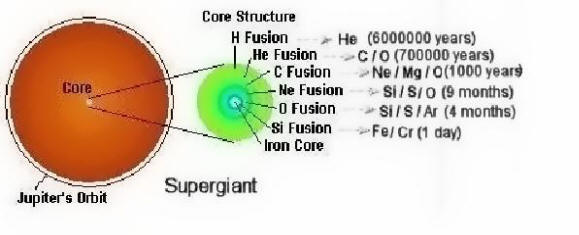
home •
about •
essential guide •
picture of the day •
thunderblogs •
news •
multimedia •
predictions •
products •
get involved •
contact
picture of the day archive subject index
Theoretical fusion reactions in supergiant stars. Credit: Universe Review
Apr 07, 2008
Stellar Dumbbell May Illustrate Electric Fissioning
A pair of stars orbiting one another at high speed and close proximity surprises conventional astronomers. In the Electric Universe, such phenomena are expected.Ohio State University astronomers and other cooperative agencies from around the world have recently announced that a pair of super giant yellow stars has been discovered orbiting so closely to one another that they are exchanging material with each other. When the first such system was discovered in the Holmberg IX galaxy, some 13 million light-years away, it was thought to be rare until another one was found almost immediately afterward. In the second case, the “yellow supergiant eclipsing binary” was found closer to home in the Small Magellanic Cloud.
Kris Stanek, an astronomy professor at Ohio State, wrote: “We didn’t expect to find one of these things, much less two. You never expect this sort of thing. But I think this shows how flexible you have to be in astrophysics. We needed the 8.4-meter LBT [Large Binocular Telescope] to spot the first binary, but the second one is so bright that you could see it with binoculars in your back yard. Yet, if we hadn’t found the first one, we may never have found the second one.”
The unexpected nature of the discovery is due to the standard theory of stellar evolution. As stars are born and begin to age, they go through stages of development that correspond primarily to their rates of fuel consumption. When stars ignite, they contain hydrogen and helium that immediately begin to transform into heavier elements because nuclear fusion takes place in their cores – lighter elements are fused together due to heat and gravitational compression. As the theory states, if the star is large enough and contains enough fuel it will reach the “red supergiant” phase before it becomes a supernova.
The largest stars burn their initial fuel charges at a rapid pace over the eons and fluctuate between hot and cool, depending on what element is being fused. Hydrogen becomes helium, which becomes carbon and so on. As the star collapses, allowing gravity to compress the core and once again burn the heavier elements, it heats up and enters a blue-white stage. Once the star accumulates enough iron atoms the nuclear reaction stops; the star implodes and throws off its outer layers. The yellow phase is not supposed to last long enough for the star to reach that end, yet that is what astronomers believe they are witnessing.
The Electric Star theory explains things differently, so the discovery is not a surprise. Not only is the conventional view of luminosity vs. spectral class overturned by its premise, the Electric Star hypothesis predicts that binary star systems at every stage of luminosity should exist. As Don Scott, author of The Electric Sky writes:
“In the ES [Electric Star] model the important variable is: current density (Amps/sq m) at the star's photospheric surface. If a star's current density increases, the arc discharges on its surface (photospheric granules) get hotter, change color (away from red, toward blue-white), and get brighter. The absolute luminosity of a star, therefore, depends on two main variables: current density at its effective surface, and its size (the star's diameter). Therefore, let us add a new scale to the horizontal axis of the HR diagram: 'Current Density at the Surface of each Star'. Consider moving from the lower right of the HR diagram toward the left. In so doing we are moving in the direction of increasing current density at the star's surface.”
What astronomers have actually done is help to confirm the hypothesis by providing image data that supports another aspect of ES theory: stellar fissioning. As Don Scott writes:
“If a sphere of fixed volume splits into two smaller (equal sized) spheres, the total surface area of the newly formed pair will be about 26% larger than the area of the original sphere. If the split results in two unequally sized spheres, the increase in total area will be something less than 26%. So, to reduce the current density it is experiencing, an electrically stressed, blue-white star may explosively fission into two or more stars. This provides an increase in total surface area and so results in a reduced level of current density on the (new) stars' surfaces. Each of two new (equal sized) stars will experience only 80% of the previous current density level and so both will jump to new locations farther to the lower-right in the HR diagram.”
By Stephen Smith
Further reading:
The Electric Universe by David Talbott and Wallace Thornhill
The Electric Sky by Donald Scott
Electric Discharge as the Source of Solar Radiant Energy by Ralph Juergens
___________________________________________________________________________Please visit our Forum
The Electric Sky and The Electric Universe available now!

|
|

|
EXECUTIVE EDITORS:
David Talbott, Wallace Thornhill
MANAGING EDITORS:
Steve Smith, Mel Acheson
CONTRIBUTING EDITORS: Michael Armstrong, Dwardu Cardona,
Ev Cochrane,
C.J. Ransom, Don Scott, Rens van der Sluijs, Ian Tresman
WEBMASTER: Brian Talbott
Copyright 2007: thunderbolts.info
![]()
home •
thunderblogs •
forum •
picture of the day •
resources •
team •
updates •
contact us

